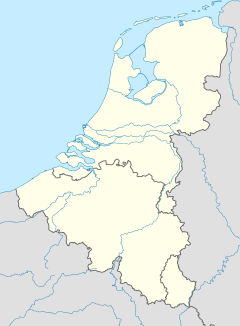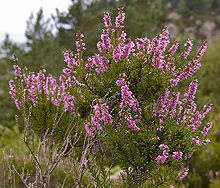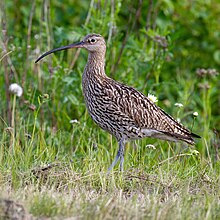Kalmthoutse Heide border park
| Kalmthoutse Heide border park | ||
|---|---|---|
|
|
||
| Location: | Noord-Brabant , Antwerp , Netherlands | |
| Next city: |
Kalmthout Belgium , Ossendrecht the Netherlands |
|
| Surface: | approx. 6000 ha | |
| Founding: | 2001 | |
| Address: | Putseseenweg 129 BE-2920 Kalmthout |
|
| Map of the national park; the purple line in the center marks the state border | ||
The border park Kalmthoutse Heide (until 2018 officially border park De Zoom - Kalmthoutse Heide ) is a nature reserve in the border region between the Dutch province of North Brabant and the Belgian province of Antwerp . The park was established in 2001 and has national park status in the Netherlands. It is also part of the European Natura 2000 network of protected areas .
geography
The national park extends over an area of about 6000 hectares on both sides of the border between Belgium and the Netherlands, with a slightly larger proportion of about 3750 hectares falling on Belgian territory. On the Dutch side, the area belongs to the municipality of Woensdrecht , in Belgium the municipalities of Kalmthout and Essen have a share in the park area. The Dutch trunk road N289 runs to the west of the border park, and the area of the Woensdrecht military airfield connects directly to the north . The largest traffic route within the park is the N111 on the Belgian side.
The landscape in the area consists mainly of extensive heathland , which is the largest remaining, contiguous heathland in Flanders . The heather is interrupted by some inland dunes and numerous small and flat moors, some of which fall dry in summer. Since the 1970s, increasing drying out of the area has been observed, which has a direct impact on the biodiversity in the affected areas. Above all, the extraction of groundwater from deeper layers is held responsible for this. Larger coniferous forests can be found especially on the Dutch side of the border . Many of these forest areas, such as the Ravenhof-Moretusbos , were once created by large landowners as a recreational area. Some other forest areas are still used for logging today.
The Grenzpark also houses some small agricultural enclaves that were created around 1900 through the drainage of previously moist heath areas. In addition to being used as arable land, these areas are now mainly used as pastures for sheep and cattle . In particular, the application of fertilizer on these areas has been viewed very critically in recent years, as negative effects on the surrounding nature reserves are feared. Therefore, the park administration endeavors to buy up these areas if possible or at least to make agreements with the local farmers about environmentally friendly management.
history
Originally the area was covered with the deciduous forests typical of Central Europe. Centuries of use of the area as pasture for cattle and sheep, however, led to a considerable decline in vegetation and the creation of extensive heather areas. The removal of pests , which was practiced in the Middle Ages and used together with the excrement of the cattle as fertilizer for the surrounding arable land, led to further deprivation of nutrients in the soil. From the 13th century , the local moors began to be drained to obtain peat as fuel. From 1850, people began to either reforest the heather in the Antwerp region with conifer trees or convert it into arable land. As one of the last larger heathland areas, the Belgian part of today's park was therefore declared a landscape protection area as early as 1941. Since 1986 the area has been part of the Ramsar Convention for the Protection of Important Wetlands. On October 17, 1988, the Flemish part was designated a bird sanctuary (Dutch Vogelrichtlijngebied ), the Dutch part followed a few years later.
Shortly before the turn of the millennium, considerations arose to unite the nature reserves on both sides of the border into a single contiguous protected area. In 2001 this led to the establishment of the De Zoom - Kalmthoutse Heide border park with a total area of around 4,000 hectares. The Dutch part received the official status of a national park in the same year. A decade later, the area of the park was expanded by another 2,000 hectares to its present size.
In April 2018, it was decided to change the park name to the shorter version Grenzpark Kalmthoutse Heide . The original double name was intended to emphasize the cross-border character of the park, but was considered too long and not easy to remember by those responsible. Furthermore, the decision was made on the assumption that the addition of the name “Grenzpark” sufficiently emphasizes this fact.
flora
The border park Kalmthoutse Heide offers a varied vegetation, which differs significantly depending on the prevailing landscape.
pagan
The most typical plant in the drier parts of the moors, the heather . The purple flowers of this species form the classic heather panorama in the national park from July to September. Mosses and lichens grow under and between the bushes , including reindeer lichen and the rare quendel silk . This parasitic plant wraps itself around young bushes and deprives them of nutrients. Other species that grow in large numbers are, for example, the grass , the pill-sedge or the three-toothed tooth . Also bloodroot , Hairy and Genista anglica occur in this area.
The wetter sections are mainly dominated by the bell heather . This is often associated with species such as the German turf rush , the bulky rush and the narrow-leaved cotton grass . Mud lily and lung gentian are much less common. Various pioneer plants such as the medium and round-leaved sundew , the brown and white Schnabelried and occasionally the rare swamp moss can be found along the paths, on the banks of small lakes and in areas with pest management . These species-rich sections of moist heather are particularly valuable from an ecological point of view and in some cases are of internationally recognized importance.
Woods
There are extensive wooded areas in the Dutch part of the park in particular. Most of these forests are quite young and were mostly created in the 19th century by reforesting the former heather. If these were not used as park forests, they were mostly intended for logging in order to meet the industrial demand for fuel and support beams for coal mines. Since the area was protected, the park administration has tried to make the forests more natural. For example, non-native species are actively removed in order to support the spread of naturally occurring species.
The forests consist to a large extent of pines such as the maritime pine , the Scots pine and the black pine . The maritime pine, in particular, was planted in large numbers in the 1950s due to its rapid growth. On the somewhat remote edges of the park there are also small deciduous forests with pedunculate oaks , buckthorns , white berries and birches . The undergrowth is mainly made up of blue pipe-grass and wire-smith . As problematic invasive species , the late blooming bird cherry and the rhododendron are being actively combated today .
Fungal fauna
A multifaceted funga with species such as the toadstool , the thick-skinned potato bovist , the lemon- leaved deaf fungus and the pearl mushroom can be seen in the national park, especially in autumn .
Inland dunes
On the open sand areas of the inland dunes in the area, there is an extreme microclimate , in summer the temperatures can rise up to 50 ° C in places. Only outspoken specialists like the silver grass , the sand sedge or the spring spark can survive here. These pioneer plants consolidate the sand and prepare the ground for subsequent species.
fauna
pagan
The structurally rich heather of the Grenzpark offers ideal conditions for countless insects and arachnids . The nectar of the heather plants is harvested by wild bees and bumblebees , especially in damp summers, in addition to honey bees . The butterflies are particularly rich in species and are represented , for example, by the blue-goose clover , the green hairstreak or the small fire butterfly . Furthermore, locusts such as the short-winged bite insects or canopy spiders , which are known for their ornate web structures, can be found in the heather .
The large number of insects feeds an equally diverse avifauna , including species such as the honey buzzard , the woodlark , the tree pipit , the stonechat and the fitis . A particularly conspicuous species is the curlew , which is becoming increasingly rare in Central Europe due to habitat loss. Furthermore, various species of migratory birds use the heather as a resting place on their hikes. These include the common snipe , the northern gray shrike and the wood sandpiper .
In addition, three types of reptiles can be found in places with many sunny spots : the forest lizard , the smooth snake and the adder .
Woods
The forests within the park are suitable as a habitat for the typical mammals of the region such as deer , red fox , ermine and European polecat . The rare pine marten also still occurs in the Kalmthoutsen Heide. Four of the five species of woodpecker native to the Netherlands can be found in the forests: small woodpecker , great spotted woodpecker , green woodpecker and black woodpecker . The tawny owl and the long-eared owl are well represented . Some other representatives of the birds in this area are for example the pied flycatcher , the common redstart and the wood warbler .
The large mounds of the red wood ant , which forms numerous colonies in the Kalmthoutsen Heide, are a striking feature of the sunny transitions between forest and heather .
Moors
Most of the water in the small moor lakes in the area is very poor in nutrients and acidic, but it is also very clear and free of pollution. They form the habitat of some rare amphibians such as the moor frog , the natterjack toad and the newt . There are also nearly 30 different types of dragonflies , which are the main food source for the falcon that nests in the area. In addition to numerous other birds, the Canada goose can also be observed here. This species is not native to the area, but there has been a population of escaped animals since the early 1970s. The first breeding success was documented here as early as 1973, today several dozen breeding pairs live in the Kalmthoutse Heide.
administration
The management of the border park Kalmthoutse Heide is divided between several Dutch and Belgian organizations. On the Belgian side, these are the Agentschap voor Natuur en Bos and the Naturschutzverein Natuurpunt . The Dutch side is represented by the Vereniging Natuurmonumenten and Staatsbosbeheer . Together they draw up the management plan for the area and maintain the De Vroente visitor center in the town of Kalmthout. Here visitors can find out more about the nature and history of the border park.
literature
- Hedwig Lauriks, Marc Slootmaekers: Grenspark De Zoom-Kalmthoutse Heide; groots en border loos . 1st edition. WPG BE Davidsfonds, 2012, ISBN 978-90-5826-863-1 .
Web links
Individual evidence
- ↑ a b Kalmthoutse Heide. In: vlaanderen.be. Retrieved August 17, 2018 (Dutch).
- ↑ Vennes. In: grensparkzk.be. Retrieved August 20, 2018 (Dutch).
- ↑ Bosses. In: grensparkzk.be. Retrieved August 16, 2018 (Dutch).
- ↑ Weilanden. In: grensparkzk.be. Retrieved August 17, 2018 (Dutch).
- ↑ Divorce. In: skynet.be. Retrieved August 20, 2018 (Dutch).
- ^ After-LIFE Conservation Plan. In: europa.eu. February 2012, accessed August 20, 2018 (Dutch).
- ↑ Kalmthoutse Heide Grenspark. In: vvvbrabantsewal.nl. Retrieved August 20, 2018 (Dutch).
- ↑ Wil de Jong: Grenspark De Zoom is voortaan Grenspark Kalmthoutse Heide. In: bndestem.nl. April 25, 2018, Retrieved August 17, 2018 (Dutch).
- ↑ Flora van de droge heide. In: grensparkzk.be. Retrieved August 17, 2018 (Dutch).
- ↑ Flora van de natte heide. In: grensparkzk.be. Retrieved August 17, 2018 (Dutch).
- ↑ Bosses. In: grensparkzk.be. Retrieved August 17, 2018 (Dutch).
- ↑ a b Flora van de Bosses. In: grensparkzk.be. Retrieved August 17, 2018 (Dutch).
- ↑ Flora van de duinen. In: grensparkzk.be. Retrieved August 17, 2018 (Dutch).
- ↑ Fauna van de Heide. In: grensparkzk.be. Retrieved August 20, 2018 (Dutch).
- ↑ Fauna van de bossen. In: grensparkzk.be. Retrieved August 20, 2018 (Dutch).
- ↑ Fauna van de vennen. In: grensparkzk.be. Retrieved August 20, 2018 (Dutch).
- ↑ De Vroente. In: lne.be. Retrieved August 20, 2018 (Dutch).







